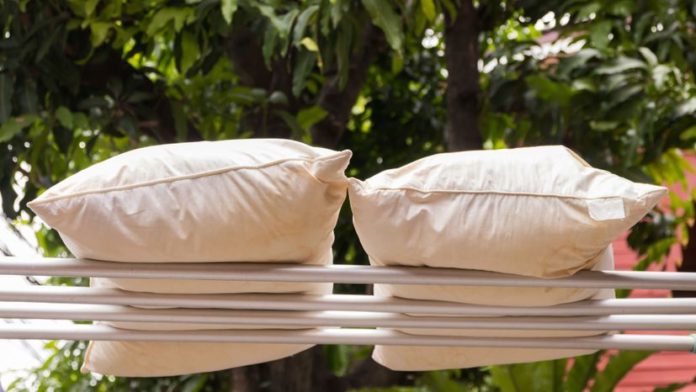\”
 \”How long has it been since you washed your bed pillow? Don\’t answer — just know you should do it a least a couple times a year. PJjaruwan/Thinkstock
\”How long has it been since you washed your bed pillow? Don\’t answer — just know you should do it a least a couple times a year. PJjaruwan/Thinkstock
Although most pillows have a tag giving laundering instructions, few people bother to wash them. We think they\’re shielded from the day-to-day grit and grime of life, thanks to the pillowcase. Or else, that washing them may ruin them.
But, the standard pillowcase is typically only made of cotton or some other easily permeated fabric, rendering the pillow susceptible to pretty nasty stuff.
"Even with a protective pillow case, your pillow can be filled with dust mites, body oils, and bacteria from your saliva," explains Mary Marlowe Leverette, housekeeping and laundry expert with The Spruce in an email. "All of that is next to your face and no one wants any of that."
Regular close-proximity exposure to any of these contaminants, or others like pet dander, can cause illness or allergies to flare up. It\’s no small amount of junk, either. "Your pillow doubles in weight over a span of time from absorbing dust, mold, bacteria, allergens, and dead skin when we sleep on them," write the experts at Clean My Space.
The good news is that laundering pillows is a surprisingly easy task.
Pillow-washing Protocol
If you use a zippered pillow protector, good on you! Martha Stewart says you\’ll only need to wash the pillows twice per year, although the protectors themselves require monthly laundering.
But there could be times when you need to launder your pillow more frequently. "If the user applies face lotions before going to bed or if the user has oily skin or scalp, washing more often may be needed to keep it fresh," emails Mary Zeitler, consumer scientist with Whirlpool Corporation\’s Institute of Home Science. Ditto that if you sleep with a pet or have recently had a cold or other contagious illness. Or if the pillow looks or smells musty (do you drool in your sleep?). Further, if you don\’t use a pillow protector, the Spruce says to wash the pillow monthly or every other month — which might be a stretch for most people.
So how do you clean your pillow? It\’s vital to check the care directions on the tag. "Most pillows are washable but it is important to know what type of filling is in your pillow," The Spruce\’s Leverette says. Adds Zeitler, "Most pillows are machine washable; however, there are some pillows like memory foam that are not."
In general, Zeitler recommends washing down feather and synthetic material pillows in the warmest water considered safe for the material, two per load. "This will help keep the washing machine balanced when spinning," she says. Use a mild liquid detergent, rather than residue-inducing powder and set your the machine on the gentle cycle. An extra rinse cycle is also a good idea to make sure all the soap is gone.
When it\’s time to dry, use a low-heat or air cycle setting for as long as is necessary to get all the moisture out of your pillows. Any dampness left behind will encourage mold growth. The experts at Clean My Space suggest getting two clean tennis balls and tying them up separately inside two socks. "The tennis balls will help beat out excess moisture while putting them in socks will prevent the smell and color of the tennis ball from transferring to your pillows," they write, adding, "It may take a few cycles to fully dry the pillows. Once dry, take a deep smell of the pillow to test if there\’s still moisture in the pillow."
Foam pillows are a completely different animal, so to speak. They can\’t get excessively wet (unless otherwise stated on the care tag), so rather than using a washing machine it\’s time to haul out the old vacuum. Then, toss them in the dryer on a "no heat" cycle to shake any additional dirt and grime loose. If any spots or other grime are visible, sparingly spot clean with water and mild soap.
Now That\’s Cool
Clean My Space suggests replacing pillows every two years, but this frequency depends on how much you use the pillow in question and how hard you are on it. To determine if the pillow is way past its prime, they suggest folding the pillow in half. If it doesn\’t bounce back immediately, toss it. If it does spring back, it\’s still usable.










